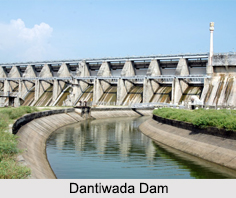 Located in the Banaskantha district of northern Gujarat, the Dantiwada Dam was constructed in 1965 on the west Banas River. Almost 8 years after its construction, the dam failed in 1973. Officially known as the Dantiwada Water Resources Project, the Dantiwada Dam was mainly built for irrigation, flood control and water supply.
Located in the Banaskantha district of northern Gujarat, the Dantiwada Dam was constructed in 1965 on the west Banas River. Almost 8 years after its construction, the dam failed in 1973. Officially known as the Dantiwada Water Resources Project, the Dantiwada Dam was mainly built for irrigation, flood control and water supply.
Overview of Dantiwada Dam
Spreading over an area of 4, 832 m and a height of almost 200 ft, the Dantiwada Dam is a mud and masonry dam. There are a total of 111 villages under the command of the Dantiwada Dam out of which 12 villages are partially submerged. The total land submerged under the reservoir includes 1,215 hectares forest land, 810 hectares wasteland and 2, 025 hectares cultivable land.
The Dantiwada Dam has a total capacity of 907.88 cubic metres and a total catchment area of 40.47 sq. km. The dam has 11 radial spillways, the type of which is ogee, which is basically in a curved shape. The spillway capacity of the dam is 7, 504 metre cube per square. In the year, 1994 to 1995, the Dantiwada Dam irrigated about 50, 284 hectares of land. On April 10th, 2015, the Gujarat Chief Minister dedicated Rs. 110 crore to the Dantiwada Dam oriented group water supply project benefiting 123 villages of 3 talukas.
Nearby Attractions of Dantiwada Dam
The Dantiwada Dam is currently a prime tourist attraction because of the Balaram Ambaji Wildlife Sanctuary which is located nearby and forms the separation point between the Dantiwada Dam and Dharoi Dam. Constructed on 1989, this wildlife sanctuary derives its name from the two historical temples- Balaram and Ambaji, situated at the opposite corners of the sanctuary.
This article is a stub. You can enrich by adding more information to it. Send your Write Up to content@indianetzone.com















